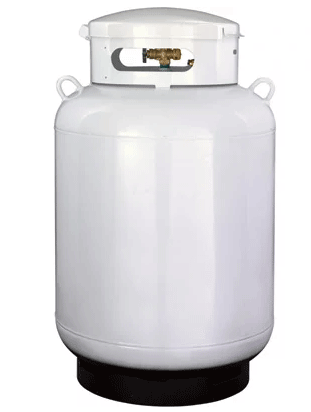It’s possible to convert a propane into an air tank suitable for your air compressor. This article will provide you with a step-by-step guide and then reader comments and responses.
Table of Contents
- Converting Propane Tank to Air Tank
- Pressure Test Propane Tank
- FAQs (Frequently Asked Questions)
- Reader Comments & Responses
Converting Propane Tank to Air Tank
One way to add an additional tank to your air compressor is to convert a propane tank into an air tank so that it is suitable for compressed air.
How do you turn a propane tank into an air compressor?
- Open valve on top of the propane tank
Place the propane tank in an open area before opening the valve (turn clockwise) at the top of the tank to expel any gas out of it. Insert a flathead screwdriver into the fitting portion of the valve and depress the check valve in the center of the fitting to let out any remaining excess gas that may be in the tank.
- Secure the propane tank
Secure the propane tank to one side of a 2 by 4 piece of wood using ratcheting tie-down straps. Then wedge the 2 by 4 between an immovable object so that any force you exude on the tank will be stopped by the 2 by 4 and the immovable object.
- Use crescent wrench to remove valve
Place the crescent wrench onto the hex-head on the top of the valve and then install a 6-foot stick of steel tubing over the handle of the crescent wrench to provide you with extra leverage. Turn the crescent wrench counterclockwise with the steel tubing until the propane tank valve is removed.
- Rinse the propane tank with water
Fill the propane tank with water from the hose and then let the water run to circulate the water through and out of the tank. Empty the water out of the tank and then fill the tank with hot water and some liquid soap. Shake the propane tank to mix the soap with the water and then empty out the tank.
- Dry out the propane tank
Proceed to rinse the tank one last time with the water from the hose and then turn the tank over to empty out the water and allow it to dry for several days.
- Pour in rust primer
Place a funnel into the hole at the top of the tank and pour in rust primer. Reinstall the propane valve loosely with your hands then proceed to rotate the propane tank end-to-end slowly in order to mix the rust primer all over the inside of the tank.
- Dry out the propane tank
Remove the propane valve and drop the air tank over the rust primer paint can to let any excess paint pour out of the tank. Again, allow the propane tank to dry for several days before adding the suitable fittings to connect it to the air compressor
Pressure Test Propane Tank
It is advised to conduct a pressure-test on the propane tank after it has been converted, if you have the ability to do so. Fill the tank halfway with water and then attach a fitting on the top that’s connected to an air compressor hose and gauge.
Fill the tank with compressed air and watch the pressure reading gauge. Make sure that the pressure meets or exceeds what your air compressor is capable of before putting it into service.
FAQs (Frequently Asked Questions)
Yes a propane tank can be used for compressed air if it is converted appropriately by emptying, cleaning and then fitting the right attachments to it.
Propane tanks are designed to hold pressures between 100 and 200 psi comfortably. It’s hard to give an exact number but know that they can handle well above what your home compressor can produce!
Depending on the temperature within the 20 lb propane tank, it will have a pressure of 145 psi at 70°F, 180 psi at 90°F, 235 psi at 105°F and 315 psi at 130°F.
Reader Comments & Responses
Use Propane Tank For Air Compressor
Question:
Can a large, say 100 gallon propane-lp tank be used with my air compressor? They seem to be cheap and available.
Response:
What is the pressure rating of the tank, Bruce?
If it’s rated for the pressure you will exert with a compressed air system, then I can’t see why not, as the tank doesn’t care if it’s liquid propane or compressed air inside.
On the other hand, if you can’t identify the pressure range for the tank, don’t take a chance.

100 gallon propane tank for compressor tank?
Question:
by Jake
(lakemoor il)
Using 100 gallon propane tank to compressor?
I have an old champion compressor that sits on a horizontal 50Gallon?? tank, it easily pumps up to 175psi, but I have this 100 gallon empty propane tank. So how do i add the tank and more importantly, how do i get that awful sulfur smell out of the empty propane tank???????
Response:
Jake, first, are you sure it’s not a 100 LB propane tank rather than a 100 gallon tank?
Regardless, you have to make sure the propane tank is rated for more than the highest pressure your compressor is rated for generating.
Then, you visit the “add-a-tank” page linked from the site map for complete details of how to plumb it up.
Over time, the flow of air into the tank will deplete and ultimately eliminate the smell. However, make sure the concentration isn’t high enough to have a fire or explosion hazard, will you?
And one other thing. How are you going to drain the tank as the condensate from the compressor slowly fills it up with water and crud?
If you have any questions regarding using a propane tank for an air compressor then please leave a comment below with a photo if applicable!
